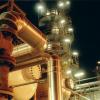Hi all,
I would like to calculate the residence time of solids (say coal) in a CSTR , i know the inlet feed rate and the outlet feed rate (which is less than the inlet feed rate at steady state).
I am using the formula residence time = volume of cstr/volumetric flow rate of solids 'in'
Is this right , or should i take the average of the inlet and outlet flow rate.
Thanks,
Tonu
|
|
3 replies to this topic
Share this topic:
#1

Posted 30 October 2012 - 08:19 AM
#2

Posted 11 November 2012 - 04:30 AM
Since no response has been received, I will try to express my view, based on University "memories".
1. Composition of Continuous Stirred Tank Reactor (CSTR) vessel is considered same as that of outlet flow rate. If no gas is produced during reaction, (average) residence time = CSTR used volume / volumetric flow rate of outlet liquid.
2. On this matter, "When the mixing is perfect, the concentration is uniform throughout the stage and the effluent concentration is the same as that in the stage; this is called a theoretical, or ideal, stage. The ideal can only be approached, the closeness depending on economics and the peculiarities of individual systems". - S. M. Walas, Reaction Kinetics for Chemical Engineers, McGraw-Hill (1959), Continuous Stirred Reactors (para 27).
3. In your case, I suppose that "carbon" is in suspension; and gas is produced, seeing that outlet rate is less than inlet rate. Gas bubbles "travel" upwards in the liquid, but volume above liquid level is just buffer volume for gas (no reaction takes place there). Residence time = CSTR used volume / (volumetric flow rate of outlet liquid + volumetric flow rate of outlet gas), where volumetric flow of gas has to be considered at same temperature and pressure as in the reactor. Residence time of "coal" is judged to be same as above.
4. More specific data was needed for a definite answer without "suppose" (real?) from me. Please do not hesitate to provide such data in the topics, it will help Readers (no, they will not be tired of it).
1. Composition of Continuous Stirred Tank Reactor (CSTR) vessel is considered same as that of outlet flow rate. If no gas is produced during reaction, (average) residence time = CSTR used volume / volumetric flow rate of outlet liquid.
2. On this matter, "When the mixing is perfect, the concentration is uniform throughout the stage and the effluent concentration is the same as that in the stage; this is called a theoretical, or ideal, stage. The ideal can only be approached, the closeness depending on economics and the peculiarities of individual systems". - S. M. Walas, Reaction Kinetics for Chemical Engineers, McGraw-Hill (1959), Continuous Stirred Reactors (para 27).
3. In your case, I suppose that "carbon" is in suspension; and gas is produced, seeing that outlet rate is less than inlet rate. Gas bubbles "travel" upwards in the liquid, but volume above liquid level is just buffer volume for gas (no reaction takes place there). Residence time = CSTR used volume / (volumetric flow rate of outlet liquid + volumetric flow rate of outlet gas), where volumetric flow of gas has to be considered at same temperature and pressure as in the reactor. Residence time of "coal" is judged to be same as above.
4. More specific data was needed for a definite answer without "suppose" (real?) from me. Please do not hesitate to provide such data in the topics, it will help Readers (no, they will not be tired of it).
Edited by kkala, 11 November 2012 - 05:00 AM.
#3

Posted 30 November 2012 - 01:13 PM
To build off of kkala:
It should be important to note that the residence time= volume/outlet is varying.
You said outlet<inlet. Therfore the tank volume will keep rising. The actual volume of the tank would then be V(t)=V(0)+(inlet-outlet)*time. Plug V(t) into the original equation for volume.
It should be important to note that the residence time= volume/outlet is varying.
You said outlet<inlet. Therfore the tank volume will keep rising. The actual volume of the tank would then be V(t)=V(0)+(inlet-outlet)*time. Plug V(t) into the original equation for volume.
#4

Posted 01 December 2012 - 02:42 AM
Markymaark, post No 2 considers steady state (constant residence time). It is given that outlet rate "is less than the inlet feed rate at steady state" (post No 1), which resulted in the interpretation of gas produced in the reactor. Other interpretations are possible.
Similar Topics
Tank Filing TimeStarted by Guest_not_mikhail_* , 17 Mar 2025 |
|

|
||
Psv Release Rate Vs TimeStarted by Guest_stu_* , 30 Nov 2024 |
|

|
||
Time Required To Heat Up A Fluid In A VesselStarted by Guest_panoska_* , 24 Jan 2023 |
|

|
||
Cstr CalculationStarted by Guest_jordan1111_* , 18 Jan 2024 |
|

|
||
Heating Coil Design For CstrStarted by Guest_zaidanamir_* , 29 Oct 2023 |
|

|

 FB
FB








